Jharkhand Board JAC Class 10 Science Solutions Chapter 6 Life Processes Textbook Exercise Questions and Answers.
JAC Board Class 10 Science Solutions Chapter 6 Life Processes
Jharkhand Board Class 10 Science Life Processes Textbook Questions and Answers
Question 1.
The kidneys in human beings are a part of the system of ……………….
A. nutrition
B. respiration
C. excretion
D. transportation
Answer:
excretion
Question 2.
The xylem in plants are responsible for ……………….
A. transport of water
B. transport of food
C. transport of amino acids
D. transport of oxygen Answer: transport of water
Question 3.
The autotrophic mode of nutrition requires ……………….
A. carbon dioxide and water
B. chlorophyll
C. sunlight
D. all of the given
Answer:
all of the given
Question 4.
The breakdown of pyruvate to give carbon dioxide, water and energy takes place in ……………….
A. cytoplasm
B. mitochondria
C. chloroplast
D. nucleus
Answer:
mitochondria
Question 5.
How are fats digested in our bodies? Where does this process take place?
Answer:
Large fat globules break into small fine droplets by the effect of bile salts of bile juice. This is called emulsification of fats.
Pancreatic lipase acts on emulsified fats to break it and finally intestinal lipase digests fats into fatty acids and glycerol. This process take place in small intestine.
![]()
Question 6.
What is the role of saliva in the digestion of food?
Answer:
Saliva contains salivary amylase (ptyalin) which digests starch into sugar.

Question 7.
What are the necessary conditions for autotrophic nutrition and what are its by-products?
Answer:
The necessary conditions for autotrophic nutrition are:
- Presence of chlorophyll
- Absorption light energy
- Splitting of water molecules
- Reduction of carbon dioxide to carbohydrates.
Oxygen is the by-product.
Question 8.
What are the differences between aerobic and anaerobic respiration? Name some organisms that use the anaerobic mode of respiration.
Answer:
| Aerobic respiration | Anaerobic respiration |
| 1. O2 is used in this process. | 1. O2 is not used in this process. |
| 2. At the end of this process CO2 and H2O are produced. | 2. At the end of this process in medium of plant origin Ethanol and CO2 are produced and in medium of animal origin only lactic acid is produced and no CO2. |
| 3. In aerobic respiration complete oxidation of glucose molecules occurs, in which one mole of glucose on oxidation releases much greater energy. | 3. In anaerobic respiration glucose molecules are incompletely oxidized, so one mole of glucose releases less energy along with the organic by products. |
| 4. There are two phases in aerobic respiration, the first phase occurs in the cytoplasm and does not utilize O2. The second phase occurs in the mitochondria and utilizes O2. | 4. There is only one phase in anaerobic respiration. It occurs in the cytoplasm. It occurs entirely in the absence of O2. |
Question 9.
How are the alveoli designed to maximise the exchange of gases?
Answer:
The alveoli are located at the terminal ends of bronchioles. They are balloon-like structures provides large surface area for exchange of gases with an extensive network of blood vessels.
Question 10.
What would be the consequences of a deficiency of haemoglobin in our bodies?
Answer:
A deficiency of haemoglobin in our bodies leads to a disease called anaemia. Due to this, cells of our body do not get sufficient oxygen for cellular respiration, which may lead to release less energy. Weakness, fatigue, tiredness, etc. conditions may arise.
Question 11.
Describe double circulation of blood in human beings. Why is it necessary?
Answer:
Blood passes through the heart twice during each cycle in human beings. This is called double circulation.
[Deoxygenated blood from different organs is drained and finally through vena cava it is poured in right atrium. Prom here this blood is transported to lungs via right ventricle. In lungs, blood become oxygenated and is again transported to left atrium. From here it transports in left ventricle and then by aorta to different body parts.]
It is necessary because it allows a highly efficient supply of oxygen to the body cells, which fulfill the high energy need of body.
![]()
Question 12.
What are the differences between the transport of materials in xylem and phloem?
Answer:
| In xylem | In phloem |
| 1. Water and minerals are transported. | 1. Food especially carbohydrate, sucrose is translocated. |
| 2. Transpiration pull becomes the major driving force for transport in xylem. | 2. Osmotic pressure is responsible for translocation in phloem. |
| 3. Generally ATP is not used for transport of material in xylem. | 3. Phloem tissue uses ATP for translocation of food materials. |
| 4. Vessels and tracheids are involved in transport. | 4. Sieve tube and companion cells are involved in translocation. |
Question 13.
Compare the functioning of alveoli in the lungs to their structure and functioning.
Answer:
| Alveoli | Nephrons |
| 1. It is a structural and functional unit of lung. | 1. It is a structural and functional unit of kidney. |
| 2. Alveoli are balloon-like structures at the terminal region of bronchioles. | 2. Nephrons are long-coiled tube-like structures having Bowman’s capsule at the tip. |
| 3. The alveoli provide a surface for exchange of gases. | 3. Filtration of blood for removing of nitrogenous wastes take place in nephron units. |
| 4. The wall of the alveoli contain an extensive network of blood vessels. | 4. A cluster of blood capillaries associated with Bowman’s capsule called glomerulus and tubular part of nephron is surrounded by network of blood capillaries. |
Jharkhand Board Class 10 Science Life Processes InText Questions and Answers
Question 1.
Why is diffusion insufficient to meet the oxygen requirement of multicellular organisms like humans?
Answer:
In multicellular organisms like human, all the cells are not in direct contact with the s surrounding environment. The body structure is more complex and the body size is also large. Therefore, simple diffusion will not be sufficient to s send oxygen to every cell. It has been estimated that a period of 3 years would be needed to carry a molecule of O2 from our lungs to reach our toes through diffusion.
So, diffusion is insufficient to meet the oxygen requirement of multicellular organisms like humans.
Question 2.
What criteria do we use to decide whether something is alive?
Answer:
Movement, growth, breathing, cell-structure, etc. are the criteria we use to decide whether something is alive.
Question 3.
What are outside raw materials used for by an organisms?
Answer:
| Name of outside raw materials | Used for |
| 1. CO2, H2O | Photosynthesis by plants |
| 2. Carbon based food source, O2 | Respiration by aerobic organisms |
Question 4.
What processes would you consider essential for maintaining life?
Answer:
The processes essential for maintaining life are nutrition, respiration, transport, excretion, etc.
Question 5.
What are the differences between autotrophic nutrition and heterotrophic nutrition?
Answer:
| Autotrophic Nutrition | Heterotrophic Nutrition |
| 1. It occurs in green plants and some bacteria. | 1. It occurs in animals and fungi. |
| 2. In such mode of nutrition. food is synthesised from inorganic components, i.e., CO2 and H2O. | 2. In such mode of nutrition food is consumed from other organisms. |
| 3. Photosynthesis is important process for autotrophic nutrition. | 3. Food digestion is important for such nutrition. |
Question 6.
Where do plants get each of the raw materials required for photosynthesis?
Answer:
Raw materials required for photosynthesis :
- CO2 : Plants get it from atmosphere.
- H2O : Plants root absorbed it from soil.
- Energy : Plants get it directly from sun.
Question 7.
What is the role of the acid in our stomach?
OR
What are the functions of the acid in our stomach?
Answer:
Role or Functions of the acid:
- Acid destroys the bacteria and other microorganisms that enter the stomach, along with the food.
- It converts the inactive enzyme pepsinogen into active enzyme pepsin.
- It provides acidic medium required for the action of pepsin. Pepsin can digest proteins present in food only in acidic medium.
- Insoluble mineral salts get dissolved in acid.
Question 8.
What is the function of digestive enzymes?
Answer:
Digestive enzymes hydrolyse / digest complex component (carbohydrates, lipids, proteins) of food into simple, soluble and absorbable form of nutrients.
Question 9.
How is the small intestine designed to absorb digested food?
Answer:
Small intestine is long tubular structure. The inner lining of the small intestine has numerous finger like projection called villi, which increase the surface area for absorption.
Question 10.
What advantage over an aquatic organism does a terrestrial organism have with regard to obtaining oxygen for respiration?
Answer:
The amount of dissolved oxygen is fairly low in aquatic environment as compared to the amount of oxygen in the air. So, terrestrial organisms fulfil their oxygen demand with low breathing rate as compared to aquatic organisms.
Question 11.
What are the different ways in which glucose is oxidised to provide energy in various organisms?
Answer:
There are three different ways in which glucose is oxidised to provide energy in various organisms.
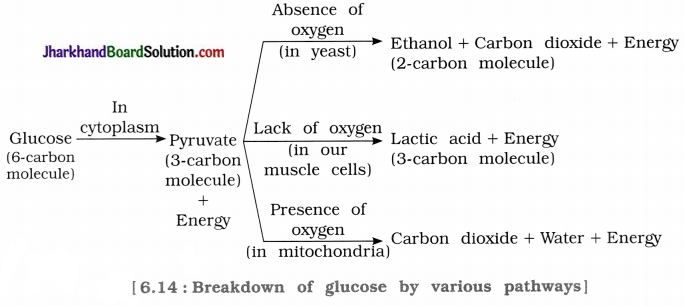
Question 12.
How is oxygen and carbon dioxide transported in human beings?
Answer:
In human beings, the respiratory pigment haemoglobin has high affinity for oxygen, so it is mostly transported by haemoglobin. Carbon dioxide is more soluble in water than oxygen and hence it is mostly transported in dissolved form in our blood.
Question 13.
How are the lungs designed in human beings to maximise the area for exchange of gases?
Answer:
The respiratory passage in the lungs, divides into smaller and smaller tubes which finally terminate in balloon – like structures alveoli. The alveoli present in lungs provide the maximum area for exchange of gases in human beings.
![]()
Question 14.
What are the components of the transport system in human beings? What are the functions of these components?
Answer:
| The components of the transport system in human | Functions |
1. Blood
|
|
| 2. Heart | It acts as a blood pumping organ. |
3. Blood vessels
|
|
| 4. Lymph | Carries digested and absorbed fat from intestine and drain excess fluid from intercellular spaces back into the blood. |
Question 15.
Why is it necessary to separate oxygenated and deoxygenated blood in mammals and birds?
Answer:
It is necessary to separate oxygenated s and deoxygenated blood in mammals and birds because it allows a highly efficient supply of oxygen to the body and this is useful in their high energy needs for to maintain constant body temperature.
Question 16.
What are the components of the i transport system in highly organised plants?
Answer:
Xylem tissue (vessels and tracheids) and phloem tissue (sieve tube and companion cell) are the components of the transport system in highly organised plants.
Question 17.
How are water and minerals transported in plants?
Answer:
Water conducting channels : Xylem consists of vessels and tracheids, which form continuous water conducting channel.
Absorption of water by the roots : The root cells actively take up ions from soil. This creates a difference in the concentration of these ions between the root and the soil. Water, therefore moves into the root from the soil to eliminate this difference.
Column of water : To eliminate the concentration difference between the soil and the root, the steady movement of water into root creates column of water.
Conduction of water by root pressure : Due to absorption of water by root cells, a pressure is generated to push water in xylem element.
This pressure is insufficient to move water over the heights of plants. So, plants use another strategy to move water in xylem upwards to the highest points of the plant body.
Conduction of water by transpiration pull : The loss of water in the form of vapour from the aerial parts of the plant is known as transpiration.
The water which is lost through the stomata is replaced by water from the xylem vessels in the leaf. Evaporation of water molecules from the cells of a leaf creates a sunction which pulls water from the xylem cells of roots.
During the day when the stomata are open, the transpiration pull becomes the major driving force in the movement of water in the xylem.
At night effect of root pressure is necessary for the upward flow of water.
Thus, transpiration helps in absorption and upward movement of water and minerals dissolved in it from roots to the leaves.

Question 18.
How is food transported in plants?
Answer:
The transport of soluble products of photosynthesis is called translocation.
- Translocation occurs in the part of the vascular tissue known as phloem.
- Besides, the products of photosynthesis, the phloem transports amino acids and other substances. These substances are especially delivered to roots, fruits, seeds and to growing organs where it is stored.
- The translocation of food and other substances takes place in the sieve tubes with the help of adjacent companion cells both in upward and downward directions.
- The translocation in phloem is achieved by utilising energy.
- Sucrose (Sugar / Carbohydrate) is transferred into phloem tissue using energy from ATP. This increases the osmotic pressure of the tissue causing water to move into it.
- This pressure moves the material in the phloem to tissues having less pressure. The phloem thus moves material according to the plant’s need.
Example: In the spring, sugar stored in root or stem tissue is transported to the buds which need energy to grow.
Question 19.
Describe the structure and functioning of nephrons.
Answer:
Nephron is a basic filtration unit in the kidneys.
- Each kidney has large numbers of nephrons packed closely together.
- Nephron is a long-coiled tubular structure which begins with a cup-shaped end. called Bowman’s capsule and it ends in collecting tubule.
- A cluster of very thin-walled blood capillaries seen in the Bowman’s capsule is called glomerulus.
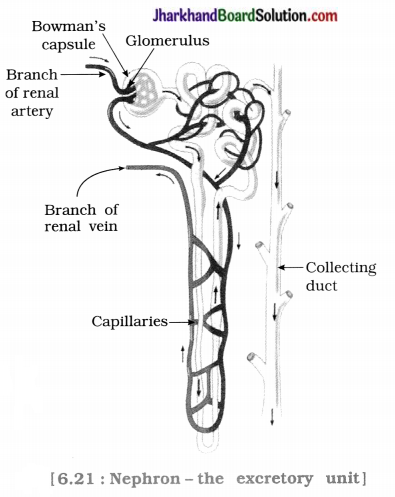
The purpose of making urine is to filter out waste products from blood.
- Nitrogenous wastes such as urea, uric acid, etc. are removed from blood in the kidneys.
- Urine is produced by filtration units i.e., nephrons.
- Cup-shaped Bowman’s capsule collects the filtrate.
- Some substances in the initial filtrate, such as glucose, amino acids, salts and a major amount of water are selectively reabsorbed as the urine flows along the coiled tube.
- The amount of water reabsorbed depends on the amount of water present in the body and amount of dissolved waste which is to be excreted.
- Thus, urine is formed in both kidneys. [In a normal healthy adult, the initial filtrate in the kidneys is about 180 L daily. However, the s volume of excreted urine is only a litre or two per day. The remaining filtrate is reabsorbed ; in the kidney tubules.]
Question 20.
What are the methods used by plants to get rid of excretory products?
Answer:
Unlike animals, the plants do not possess any special organs or system for excretion. However, the plants excrete their wastes in different ways:
- O2 produced during photosynthesis by the green plants is set free directly in the atmosphere.
- Plants remove surplus water by the process of transpiration through the stomata.
- Sometimes plants store certain wastes in the cells of their leaves which are ultimately shed off.
- Certain plants store wastes in the cellular vacuoles of their cells.
- Other waste products such as resin and gum are stored especially in old xylem.
- Plants excrete some waste substances into the soil around them.
Question 21.
How is the amount of urine produced regulated?
Answer:
The amount of urine formed depends on how much excess water there is in the body, and on how much of dissolved waste there is to be excreted. More water and dissolved wastes in the body will produce more urine. On the other hand, less water and less dissolved wastes will produced less urine.
Activity 6.1 [T. B. Pg. 96]
To demonstrate that chlorophyll is essential for photosynthesis.
Materials : Potted plant (money plant or croton), beaker, water bath, alcohol, iodine.
Procedure :
- Take a potted plant of money plant or croton with variegated leaves.
- Keep the potted plant in complete darkness for three days.
- After three days expose the plant to bright sunlight for about 6 hours.
- Pluck one such leaf of this plant which is green in certain parts and white in the other remaining parts.
- Mark the green areas in it and trace them on a papersheet.
- Boil this plucked leaf in a beaker full of alcohol and kept in boiling water bath for some time, till it becomes colourless.
- Wash and clean this colourless leaf with water and dip it, for a few minutes, in dil. iodine solution.
- Observe the colour of the leaf and compare this with tracing of the leaf done in the beginning.
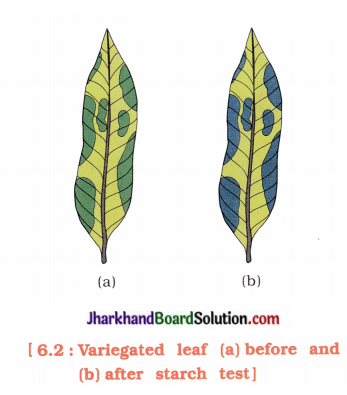
Questions:
Question 1.
What happens when the plant is kept in s a dark for 2-3 days?
Answer:
All the starch gets used up when the plant is kept in a dark for 2-3 days.
Question 2.
What happens to the colour of the leaf when keep in boiling alcohol?
Answer:
When the leaf is kept in boiling alcohol, it gets decolourised.
Question 3.
What is the colour of the alcohol solution when leaf is taken out from it?
Answer:
The colour of the alcohol solution is green when leaf is taken out from it.
![]()
Question 4.
State the use of iodine solution.
Answer:
Iodine solution is used to know the presence of starch.
Question 5.
What can you conclude about the presence of starch in various areas of the leaf?
Answer:
We conclude that the presence of starch is detected with iodine solution in only such areas where chlorophyll present.
Question 6.
What will you infer from this activity?
Answer:
This activity explains that chlorophyll is essential for photosynthesis and surplus glucose stored in form of starch as internal reserve energy.
Activity 6.2 [T. B. Pg. 97]
To demonstrate that carbon dioxide (CO2) necessary for photosynthesis
Materials : Potted plants, Bell-jar, watch glass, KOH (potassium hydroxide), alcohol, iodine solution.
Procedure:
- Take two potted plants. Place them in dark for three days. This will de-starch them.
- After three days place each of the pots on a smooth glass plate.
- Label one pot as A and the other as B.
- Keep a small watch glass or petri dish containing pellets of potassium hydroxide (KOH) on the glass plate near the pot A.
- Cover both the potted plants under two separate glass bell-jars.
- Apply a thick coat of vaseline on the bottom of the bell-jar close to the glass plate in order to make both the jars air-tight.
- Expose both these plants to sunlight for about 2 to 3 hours.
- Thereafter pluck one leaf each from the plants A and B and examine these leaves separately for the presence of starch therein.
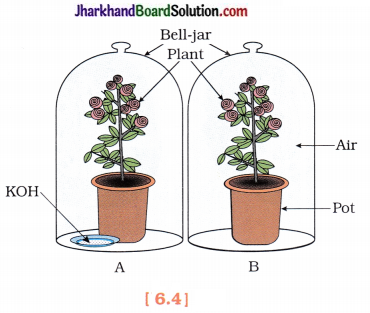
Questions :
Question 1.
Which gas is absorbed by KOH from the air in the bell-jar?
Answer:
Carbon dioxide is absorbed by KOH from the air in the bell-jar.
Question 2.
Which potted plant (A or B) shows the presence of starch in its leaf?
Answer:
B potted plant shows the presence of starch in its leaf.
Question 3.
Why is starch not formed in the leaf of the plant kept under the bell-jar with KOH kept along with it?
Answer:
Starch is not formed in the leaf of the plant kept under the bell-jar with KOH kept along with it because KOH absorbs COa from air. So, CO2 is not available for the photosynthesis and thus starch is not formed.
Question 4.
Write your inference based on your observation and study.
Answer:
The potted plant B showed normal photosynthesis in presence of CO2. This shows that CO2 is necessary for photosynthesis.
Question 5.
In order to prevent the increase of which gas in the atmosphere, the conservation of plant organisms (trees) are important?
Answer:
To prevent the increase of CO2 gas in the atmosphere, the conservation of plant organisms (trees) are important.
Question 6.
Do both the leaves show the presence of same amount of starch?
Answer:
No.
Activity 6.3 [T. B. Pg. 99]
To check the effect of saliva on starch. Materials : Two test tubes, starch solution, iodine.
Procedure:
- Take 1 mL starch solution in two test tubes (A and B).
- Add 1 mL saliva to test tube A and leave both test tubes undisturbed for 20 – 30 minutes.
- Now add a few drops of dilute iodine solution to the test tubes.
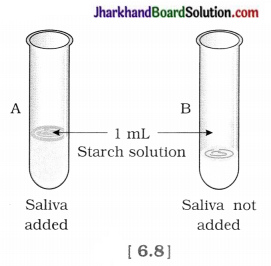
Questions:
Question 1.
In which test tube do you observe a colour change?
Answer:
In test tube B colour change is observed.
Question 2.
What does this indicate about the presence or absence of starch in the two test tubes?
Answer:
Test tube B solution showed colour change means there is presence of starch. While in test tube A colour is not changed that means starch is absent.
Question 3.
What is the difference in colour of solution, A and B after adding iodine solution?
Answer:
Colour of solution A is yellow and colour of solution B is blue or black after adding iodine solution.
![]()
Question 4.
The colour of solution in tube A does not change to blue or black. Why?
Answer:
The colour of solution in test tube A does not change blue or black because starch is hydrolysed by the effect of enzymes present in saliva.
Question 5.
Which component of food is digested (partially) when the food is chewed in the mouth?
Answer:
Starch (Carbohydrate) is partially digested when the food is chewed in the mouth.
Question 6.
Why does the bread or chapati tastes sweet when chewed for a longer time?
Answer:
When bread or chapati chewed for a longer time, starch is converted to simple sugar by salivary amylase. The sugar formed produces sweet taste in mouth.
Question 7.
State which of the following edible substances in our food are the source of starch: Potato, Lettuce leaf. Wheat, Maize, Sweet pea. Groundnut, Ghee.
Answer
Potato, Wheat, Maize, etc. are the sources of starch in our food.
Activity 6.4 [T. B. Pg. 101]
To demonstrate that CO2 is exhaled by us during breathing.
Materials : Two test tubes, Rubber tube, Pichkari, Lime water.
Procedure :
- Take two clean glass test tubes. Label one of the tubes as (a) and the other as (b).
- In each test tube add about 10 mL of freshly prepared lime water (Ca(OH)2 solution).
- Use a syringe or pichkari to pass air through some fresh lime water taken in test tube (a).
- Blow air through tube in a lime water taken in test tube (b).
- Note how long it takes for this lime water to turn milk in each test tube.
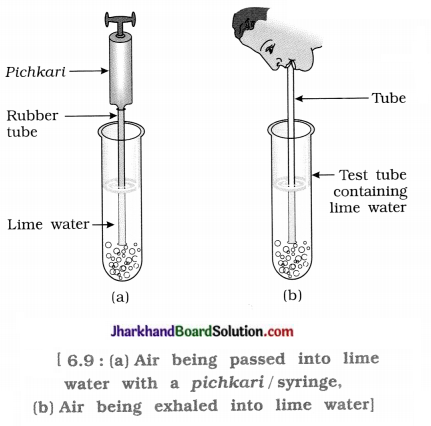
Questions :
Question 1.
What change is observed in test tube (a) and test tube (b)? Why?
Answer:
Lime water turns milky in test tube (a) and test tube (b). Because of presence of CO2 the colour of lime water is changed.
Question 2.
In which tube does the change occur more rapidly? Why?
Answer:
In test tube (b), the change occurs more rapidly because the air that we expell contain more CO2.
Question 3.
What does this activity tell us about the amount of carbon dioxide in the air that we breathe out?
Answer:
This activity tells us that the amount of carbon dioxide is more in the air that we breathe out.
Question 4.
What you conclude from this activity?
Answer:
Carbon dioxide is produced in the process of respiration.
Activity 6.5 [T. B. Pg. 101]
To demonstrate that CO2 is produced during fermentation.
Materials : Test tube. Bent glass tube, Fruit juice, Yeast powder. Lime water. One holed cork.
Procedure :
- Take some fruit juice or sugar solution and add some yeast to this mixture.
- Take this mixture in a test tube fitted with one holed cork.
- Fit the cork with a bent glass tube.
- Dip the free end of the glass tube into a test tube containing freshly prepared lime water.
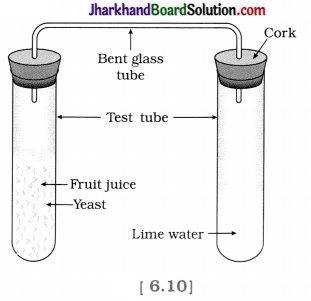
Questions :
Question 1.
What change is observed in the colour of Ca(OH)2 solution?
Answer:
The colour of Ca(OH)2 solution turns milky.
Question 2.
How much time does it take for the change of colour?
Answer:
It takes long time for the change of colour of lime water.
Question 3.
Which product of fermentation is responsible for bringing about the change in colour of lime water?
Answer:
CO2 is a product of fermentation is responsible for bringing about the change in colour of lime water.
Question 4.
What does this activity tell us about the products of fermentation?
Answer:
This activity tells us about the products of fermentation which are CO2 and ethanol.
Activity 6.6 [T. B. Pg. 103]
To compare the breathing rate of fish and human.
Materials : An aquarium
Procedure:
- Observe moving fish in an aquarium.
- Count the number of times the fish opens and closes its mouth in a minute.
- Count the number of times you breathe in and out in a minute.
- Compare the breathing count of fish with yours.
Questions :
Question 1.
What is an operculum?
Answer:
An operculum is folded covering of gill slits in some fishes.
Question 2.
By which organ do fish respire?
Answer:
Fish respires with gills.
Question 3.
Are the timing of the opening and closing of the mouth and gill-slits in fish coordinated in some manner?
Answer:
Yes, in fish when mouth opens, gill-slits close and vice versa.
Question 4.
How do fish respire?
Answer:
Fishes take in water through their mouths and force it over the gills where the dissolved oxygen is taken up by blood capillaries by diffusion and CO2 is released in water. Such water is discarded through gill slits.
Question 5.
What is an average breathing rate per minute in experimental fish?
Answer:
An average breathing rate 66-78 per minute in experimental fish.
![]()
Question 6.
What is an average breathing rate per minute in human beings?
Answer:
An average breathing rate 12-16 per minute in human beings.
Question 7.
Why in aquatic animal the breathing rate is much faster than that seen in terrestrial animals?
Answer:
Since the amount of dissolved oxygen is fairly low in water as compared to the amount of oxygen in the air, the rate of breathing in aquatic animal like fish is much faster than that seen in terrestrial animals.
Activity 6.7 [T. B. Pg. 105]
To know the haemoglobin content in human beings and in animals like buffalo, cow, etc.
- Visit a health centre in your locality and find out the normal range of haemoglobin content in human beings.
- Visit a veterinary in your locality. Find out the normal range of haemoglobin content in an animal like buffalo, cow, etc.
- Compare the difference seen in male and female human beings and animals.
Questions :
Question 1.
What is the normal range of haemoglobin content in human beings?
Answer:
The normal range of haemoglobin content 12-18 g/ decilitre.
Question 2.
Is it the same for children and adult?
Answer:
No, in children (3 month to 12 years) haemoglobin content 11.0 ± 1.5 g / decilitre.
Question 3.
Is there any difference in the haemoglobin levels for men and women?
Answer:
Yes, Men ⇒ 13-18 g / decilitre
Women ⇒ 12-16 g / dl
Question 4.
Is the haemoglobin content different in calves, male and female animals?
Answer:
Yes.
Question 5.
What is the normal range of haemoglobin content in cow and buffalo?
Answer:
Cow-10 to 15 g /decilitre
Buffalo -12.5 to 14.5 g / decilitre
Activity 6.8 [T. B. Pg. 109]
To demonstrate the physiological process of transpiration in plant.
Materials : A pot with growing plant, a pot with similar size with same amount of soil. a stick, plastic sheet.
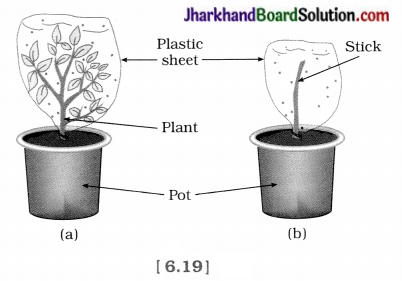
Procedure:
- Take two small pots of approximately the same size and having the same amount of soil.
- One pot labelled as (a) with a plant.
- Place a stick of the same height in other pot labelled as (b).
- Cover the soil in both pots with a plastic sheet.
- Cover both pots, with plastic sheets and place them in bright sunlight for half an hour.
Questions :
Question 1.
Why the soil in both pots is covered with a plastic sheet?
Answer:
The soil in both pots is covered with a plastic sheet to prevent evaporation and loss of moisture.
Question 2.
What do you observe after half an hour?
Answer:
After half an hour, small water droplets are observed on the inner surface of a plastic sheet of pot (a).
Question 3.
What do you conclude from your observation?
Answer:
From our observation, we concluded that there is a water loss from aerial part of a plant in the form of vapour. This process is called transpiration.